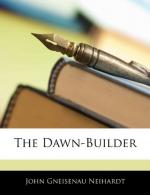|
This section contains 1,950 words (approx. 7 pages at 300 words per page) |

|
[Neihardt's] youthful lyrics show his attentiveness to poetic forms; testing meters and rhyme schemes, he experimented with free verse and chant forms of the Omahas, as well as rhythm and sound combinations. By the end of his lyric period he had rejected the influence of Whitman, abandoned free verse, and modified the super-sonics of Poe and Swinburne that affected him temporarily. In his matured poetic technique he shows most clearly the influence of F.W.H. Myers' theory that rhythm and sound, through the manipulations of vowel and consonant combinations, pause and stress, create an emotional overtone to reinforce the mood and sense of poetry by releasing a subconscious human response unbounded by century or geography. From his self-taught study of Greek Neihardt worked for compression of images in a disciplined economy of expression fostered by the use of rhyme. He thought that the same poem, written in...
|
This section contains 1,950 words (approx. 7 pages at 300 words per page) |

|


